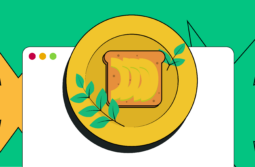Whether you already have an up-and-running landscaping business or just plan on starting one, you need a solid understanding of how to present your services online. From this post, you’ll learn how to make sure everything is rosy on your landscaping website, including your selling points, copy, visuals, and service descriptions. We’ll also provide you with the finest landscaping website examples to demonstrate what’s possible. Let’s dig in!
Content:
What are landscaping websites for?
A landscaping website is a must-have for any professional or company wishing to promote their landscaping services and connect with potential clients. These websites act as a virtual portfolio, allowing businesses to demonstrate their expertise in garden design, irrigation, lawn care, tree removal, and hardscaping, in a visually appealing way.
Landscaping websites come with a variety of benefits:
- Generally informing consumers about your business. Your website serves as a one-stop shop for all the information clients need, including services offered, pricing, contact details, and frequently asked questions.
- Proper project presentation. A website allows you to present your past projects in an appealing way, with high-resolution images and concise descriptions, giving potential clients a clear idea of your style and expertise.
- Targeting and acquiring new local customers. By optimizing your website for search engines (SEO), you can reach a broader audience, attracting clients who are searching for landscaping services in your area.
- Establishing credibility. A professional website helps build trust with potential clients. It gives you an opportunity to show off your customer testimonials, certifications, awards, and stunning before-and-after project photos.
- Providing easy connection opportunities. Potential clients can easily reach out through contact forms, schedule consultations, request quotes, or even get a quick estimate directly from your website, making it easier to convert visitors into customers.
- Improving brand recognition. A well-designed, intuitive, and mobile-friendly website reflects your brand’s identity, helping to create a strong and memorable impression on visitors. It also helps set your company apart from the established competition, who often tend to have rather outdated resources.
Having a landscaping website is essential for growing your business, enhancing your brand, and connecting with a new audience. However, that is only possible when you pay attention to each and every element of your site, making sure it’s informative, eye-catching, and actionable.
Landscaping website design tips and tricks
When it comes to website design, one size definitely doesn’t fit all because each business is unique, with its one scope of projects, expertise, and target audience. Nevertheless, there are some universal rules, following which can instantly make any landscaping website design more effective and converting. Each of them is accompanied by a real-life landscaping website example showing how it’s done.
Let the images do the talking
Landscaping is a business where aesthetics play a central role. Arriving at your website, your potential clients want to see what your company is capable of and envision the transformation you can bring to their space.
The best way to convince them is by using a visually stunning portfolio consisting of professional, high-resolution photos of your projects. Images should be well-lit and show different angles and details of your work. Before-and-after shots will help emphasize the impact of the transformation.
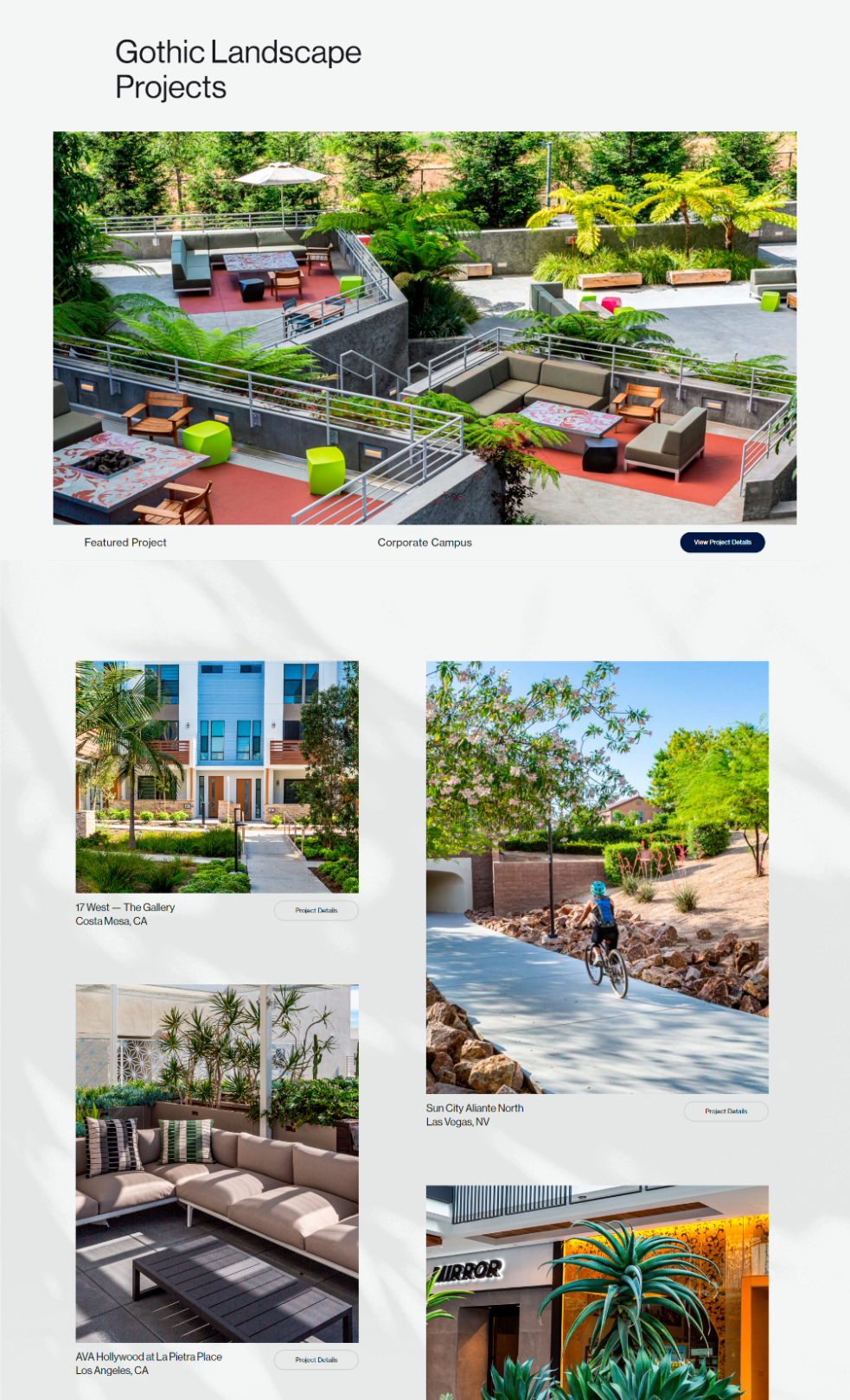
It’s also a good idea to show the diversity of your client base, implying that you know how to work with people from different backgrounds and cultures and how to recognize and cater to their unique landscaping needs.
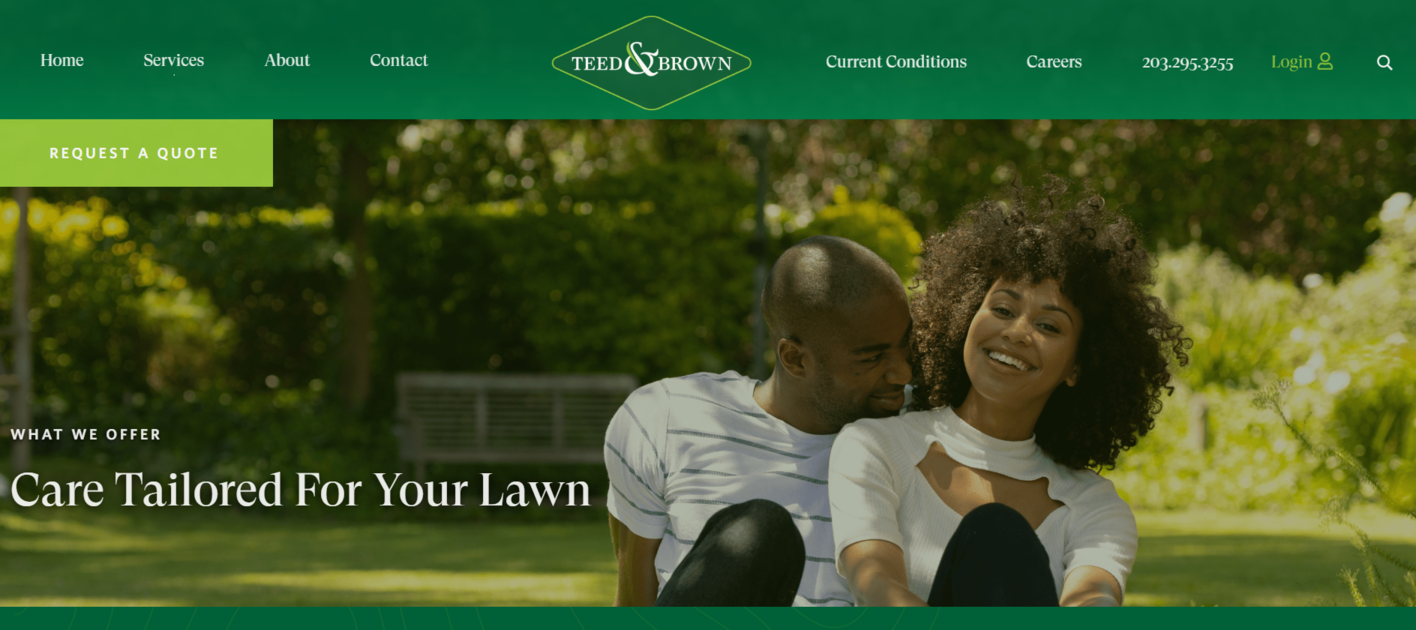
An even better solution would be to include a few images of your happy clients in their backyard, enjoying the lush garden you’ve helped create. Of course, it’s crucial to obtain their permission before publishing such photos. For privacy concerns, you also need to make sure there’s no way to identify the exact address of the property.
Visually highlight your services
To help your clients set the right expectations, clearly list and describe the services you offer, such as garden design, lawn care, or masonry. Make sure to visualize them to help even not-so-garden-savvy people understand what kind of work you do and what “xeriscaping” means.

To avoid overloading your homepage, it’s important to equip your website with a simple, intuitive menu that allows visitors to find other essential information quickly. Important sections might include “Portfolio,” “About Us,” “Testimonials,” and “Contact Us.” A user-friendly navigation keeps visitors on your site longer and reduces the chance of them leaving due to frustration.
Design with smartphone users in mind
Contrary to popular belief, even big-ticket items are often bought from smartphones due to the convenience they offer. This is why it’s important to ensure your website is responsive, meaning it adjusts to different screen sizes and looks good on both desktops and mobile devices.
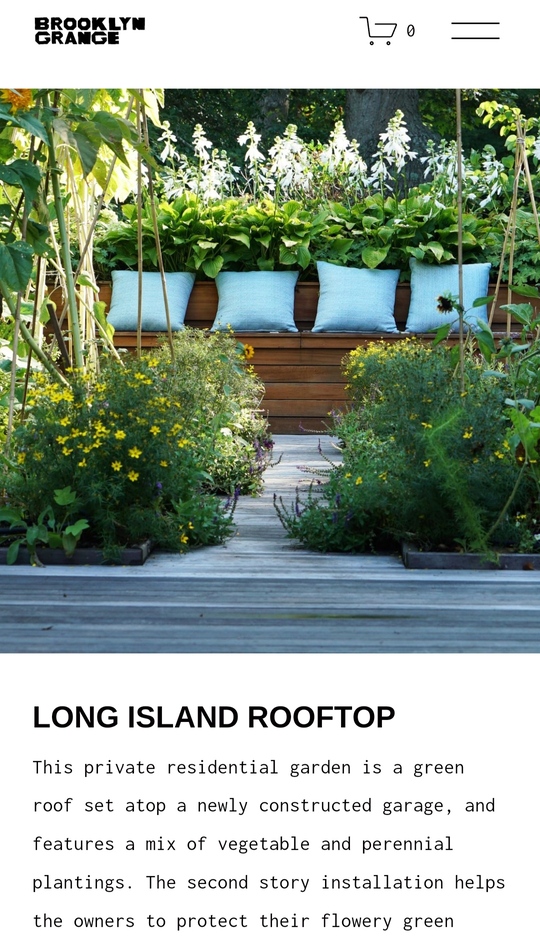
Pay attention to how easy it is to place a request from a smartphone and whether your projects and their descriptions are displayed correctly. All the key sections of the website should easily be accessible from any device.
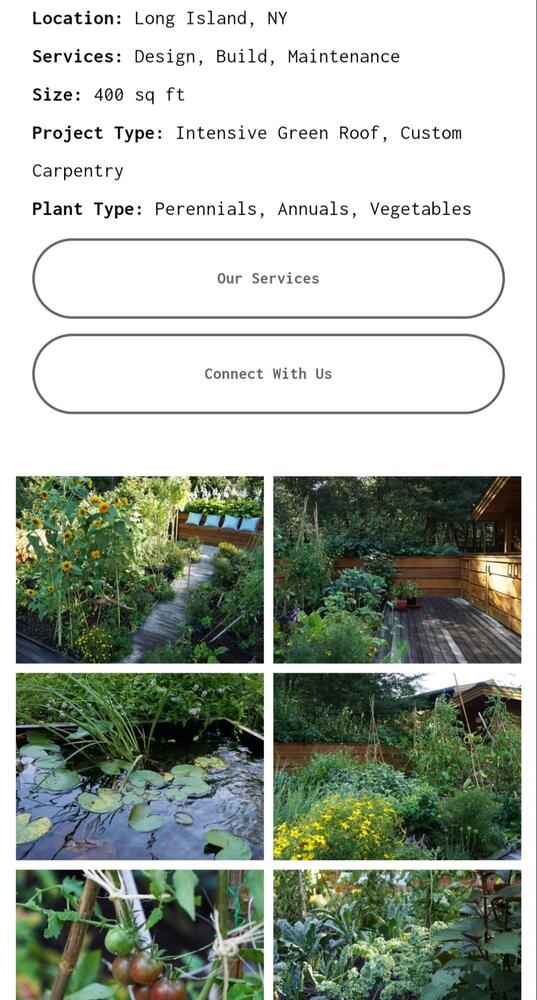
Having a minimalist design, like in this landscaping website example, will let your visitors focus on the beauty of your work and quickly establish whether your services correspond with their needs.
Make your calls to action irresistible
When your visitors are presented with stunning landscaping projects, they are likely to imagine their own property transformed in a similar way. You can help them immediately act on that desire by strategically placing CTAs throughout your site.
Use strong, clear CTAs like “Request a Quote,” “Let’s Chat,” or “Contact Us” to spark activity. Place these buttons in prominent areas, such as at the top of the page or after service descriptions, and keep them clutter-free.
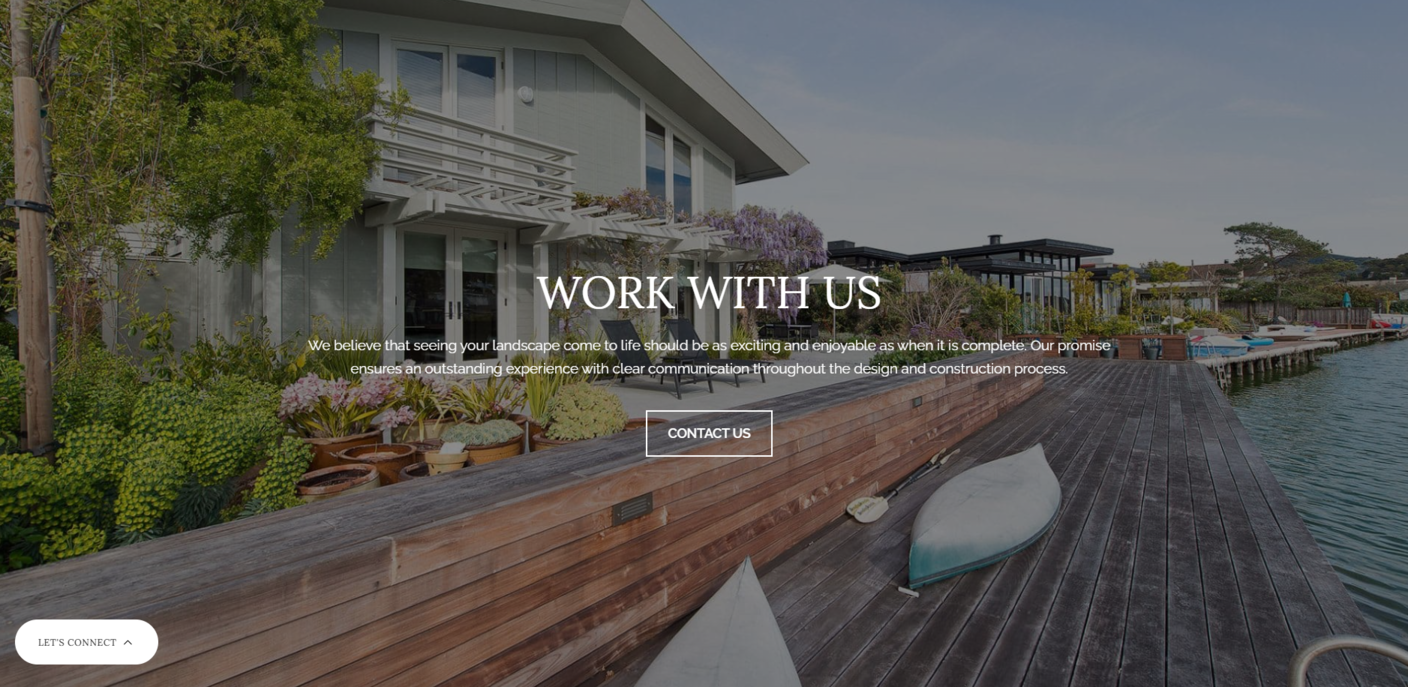
Effective CTAs guide visitors toward taking the next step, helping you convert traffic into leads and shorten the time spent on pondering your offer.
Draw attention to your value-packed content
For landscaping professionals, it’s always a good idea to create a blog where they can share landscaping tips, project highlights, and industry insights, boosting their site’s SEO and establishing their thought leadership.
But, to make sure your content is noticed and appreciated, you need to make your website blog easily discoverable.
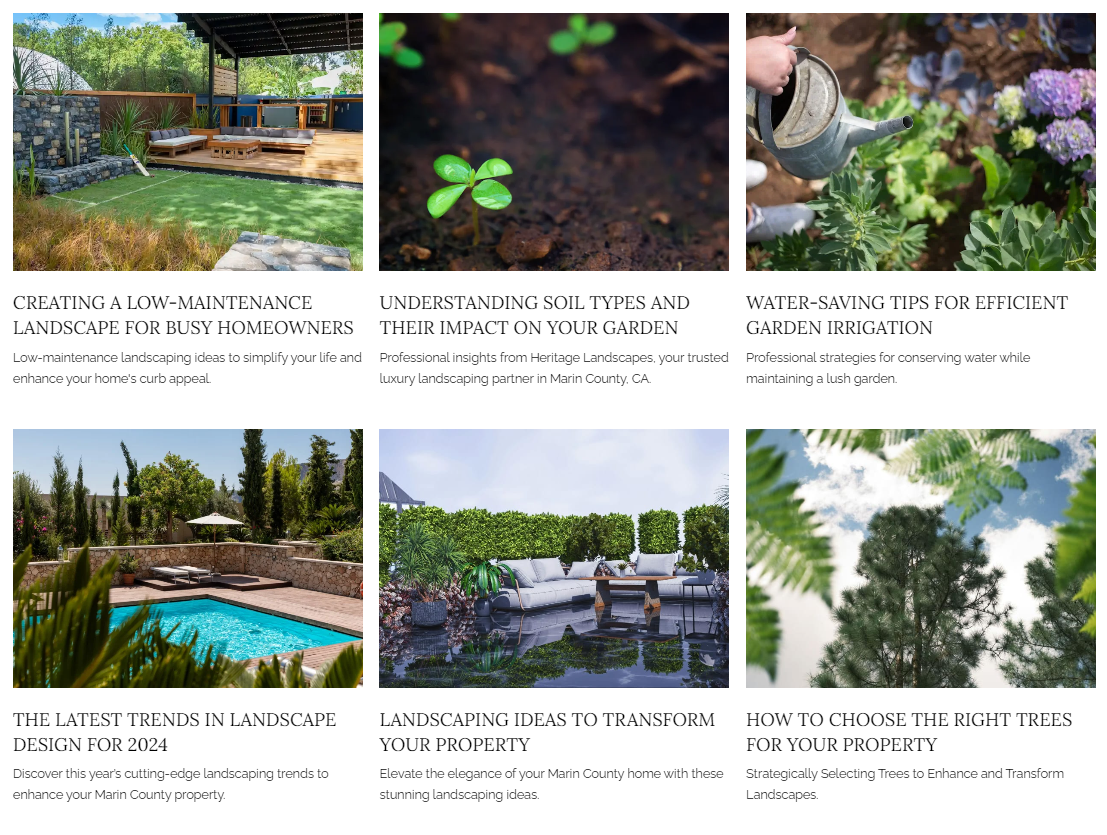
For that, give your blog articles concise and enticing descriptions, motivating users to dive deeper into each of them. For your previews, choose vibrant, non-generic images that match the content of the articles. If there are well over ten articles, you may want to introduce some sort of navigation system or search filters.
Add social media buttons
Adding links to your social media profiles and embedding Instagram feeds is a great way to showcase your projects from yet another angle. It allows visitors to engage with your brand in a more interactive and informal way and witness your work in progress.
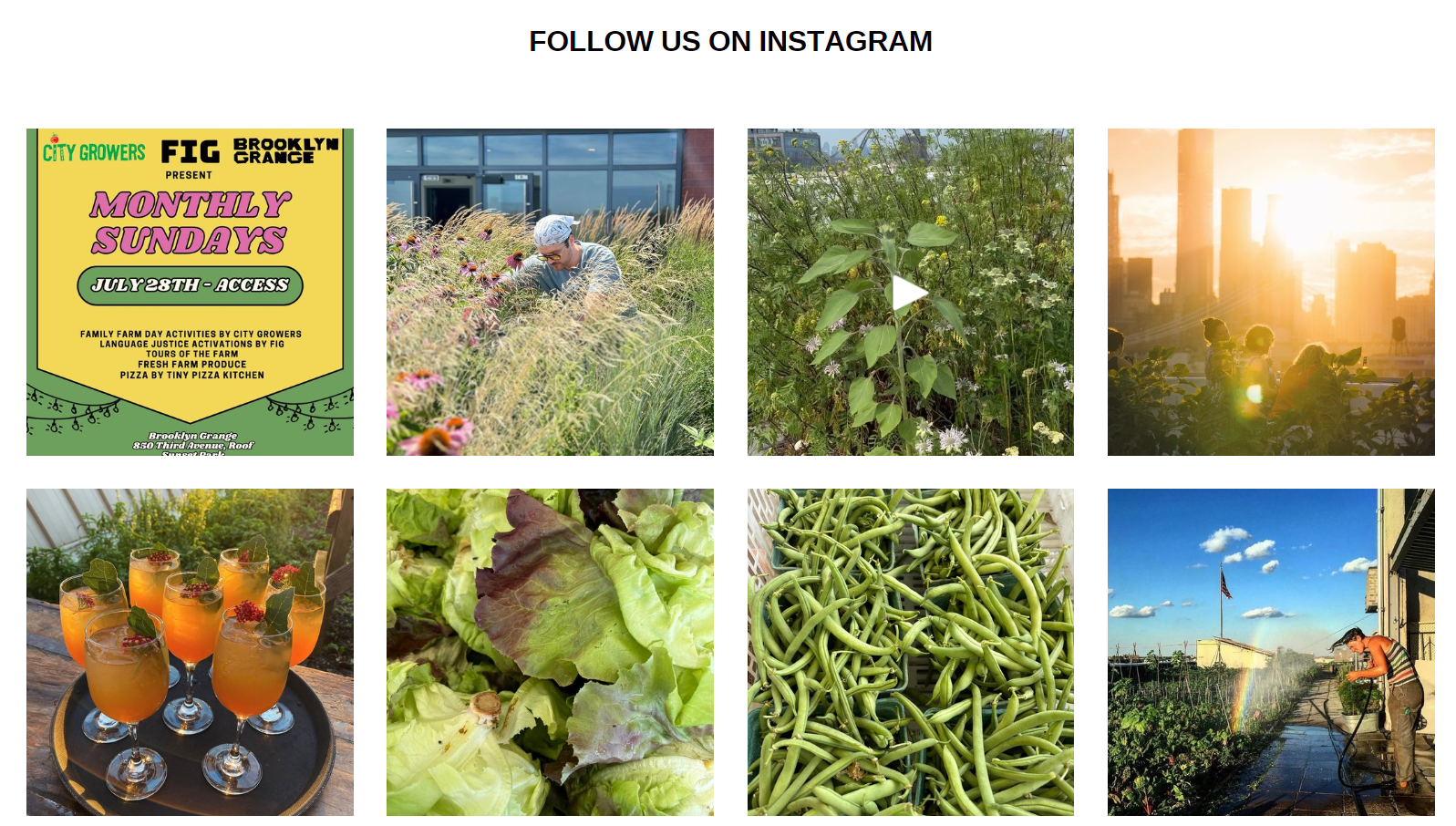
Social media are also great for publishing less polished and refined content, which makes your company more relatable and down-to-earth. These channels allow you to introduce your team, give your audience sneak peeks into your work, and highlight industry events you’re participating in.
Make it easy for clients to contact and visit you
As a service provider looking to grow your customer base, you want to make the process of contacting you as frictionless as possible. To achieve that, dedicate an entire website section or page to your contact information, including your phone number, email, and physical address. Accompany them with a website contact form if you want to save your clients extra steps.
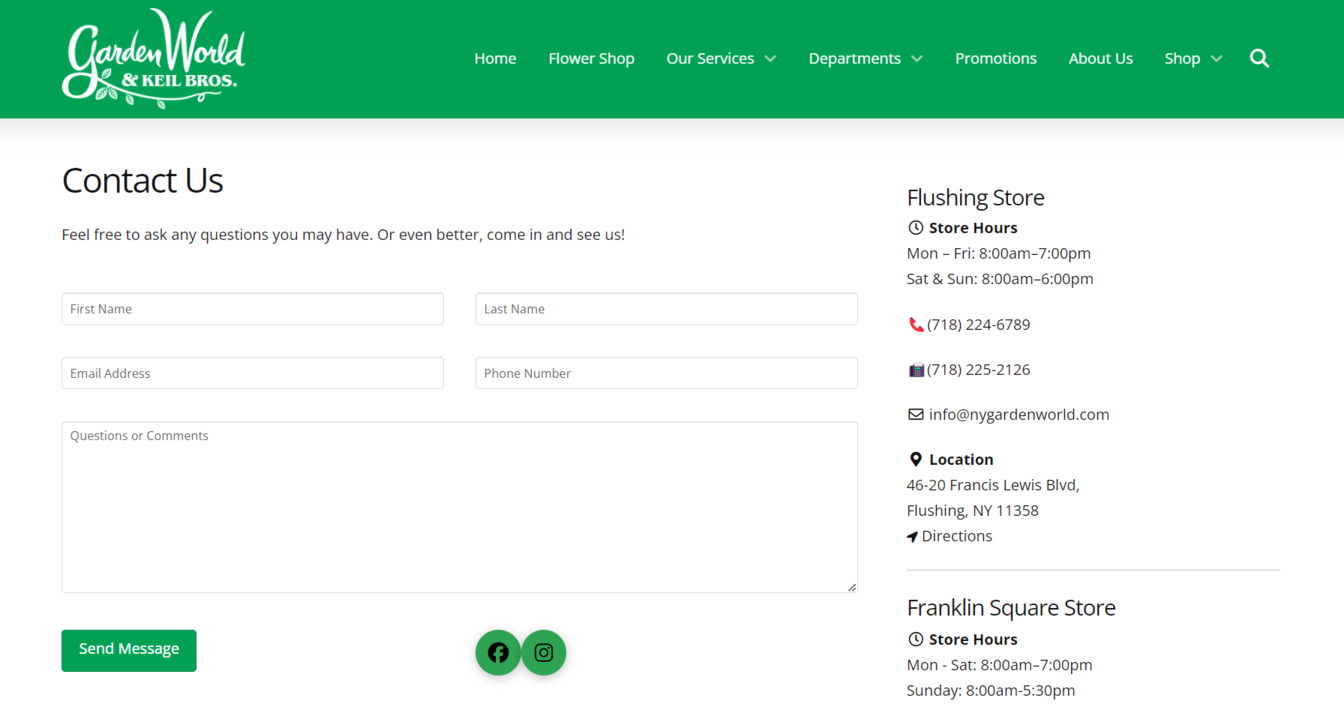
Easy access to contact information encourages potential clients to reach out, which can lead to more business opportunities. If you tend to meet new clients in your office before visiting their property, give them clear directions to make sure they won’t get lost.
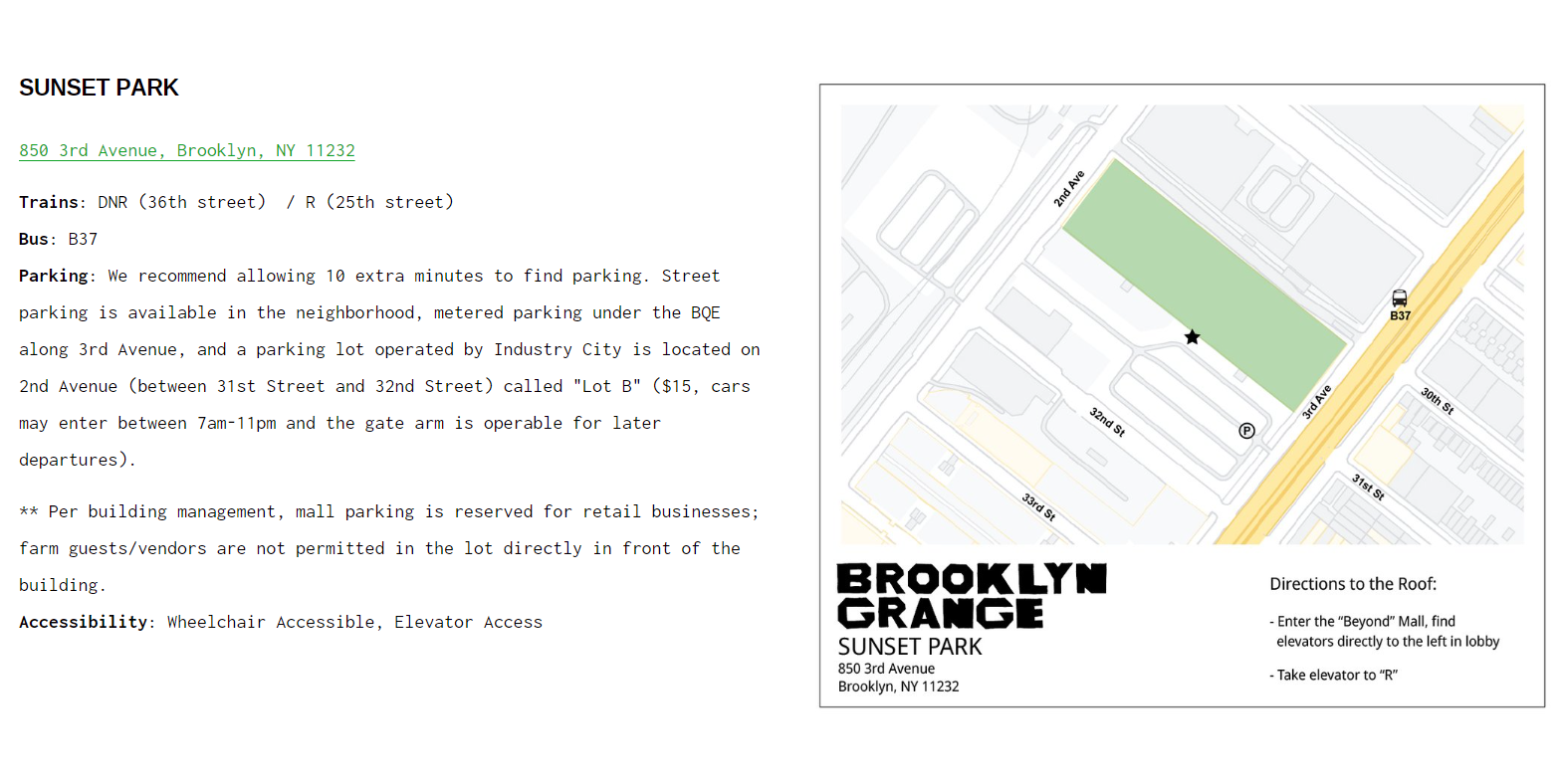
By clarifying the details like the parking situation around your office, you show that you care about every step of your customer’s experience.
Anticipate your visitors’ needs
To stay one step ahead of your potential clients, you can introduce a quiz, which can help with assessing customer needs and sorting and prioritizing incoming requests. This is a fantastic way to establish the person’s budget, constraints, expectations, and preferences before you even talk to them.
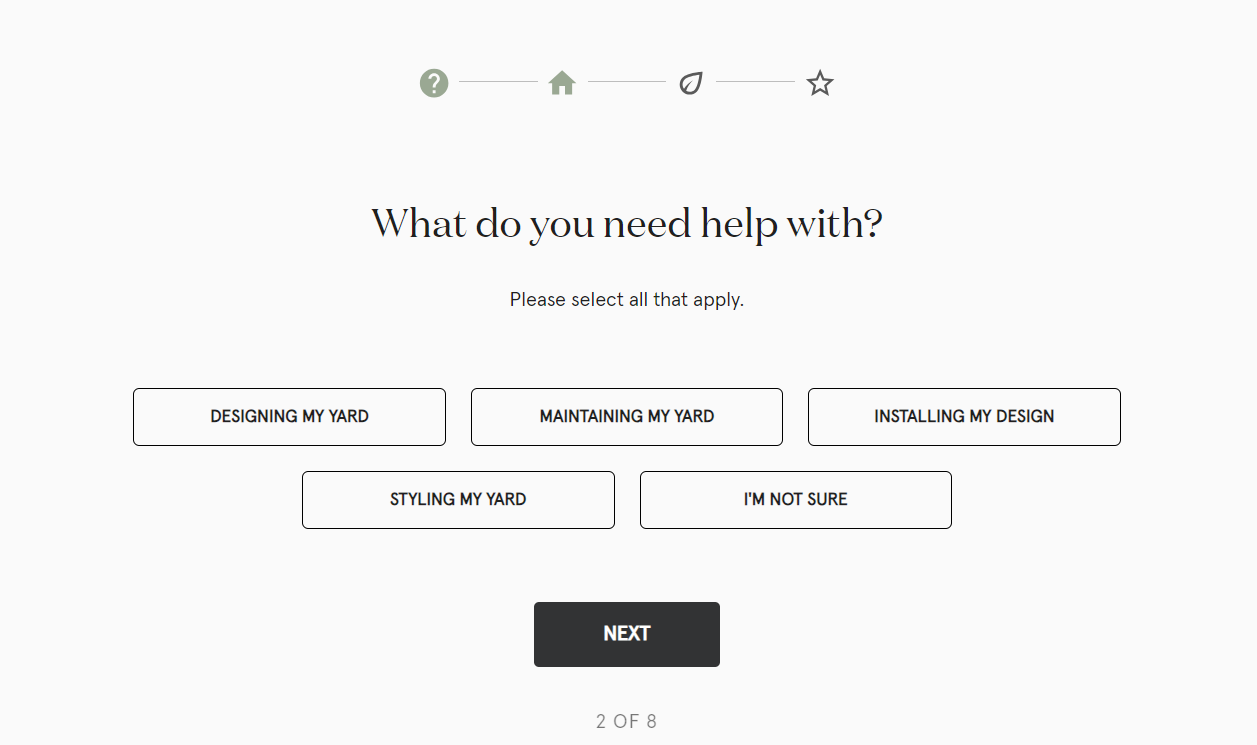
The key here is to keep the quiz as simple and conversational as possible to not intimidate new visitors, who are probably not ready to make a commitment yet.
Turn your finished projects into exciting stories
It makes sense to reserve some website space for showcasing large and complex projects, especially if you can accompany them with thrilling descriptions. By explaining your process, the client’s goals, and how you achieved them, you demonstrate your expertise and problem-solving skills.
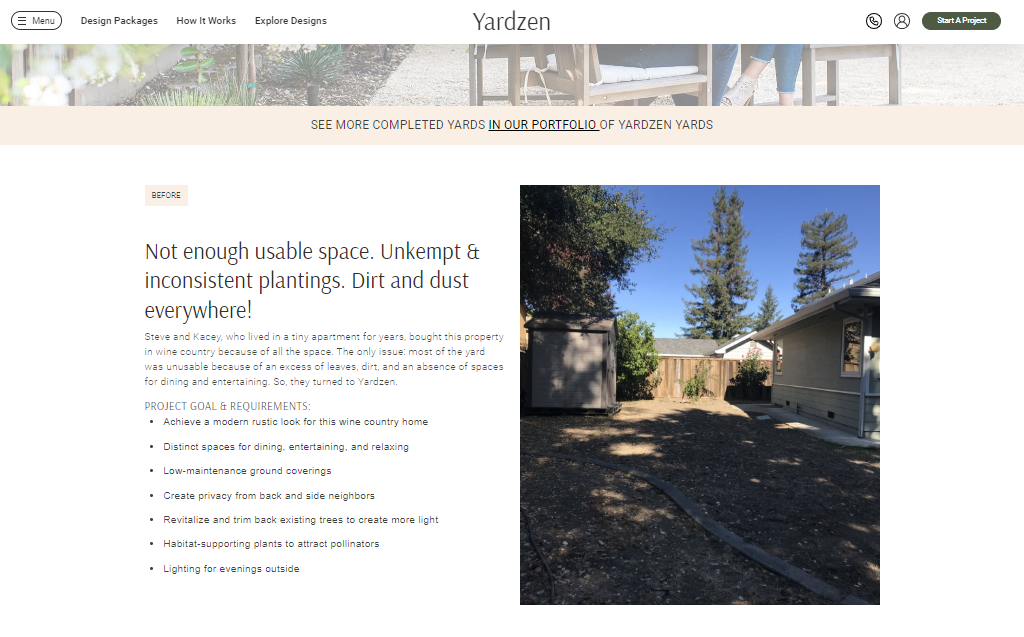
This is an appropriate place for before-and-after comparisons, which highlight the positive changes you’ve accomplished.
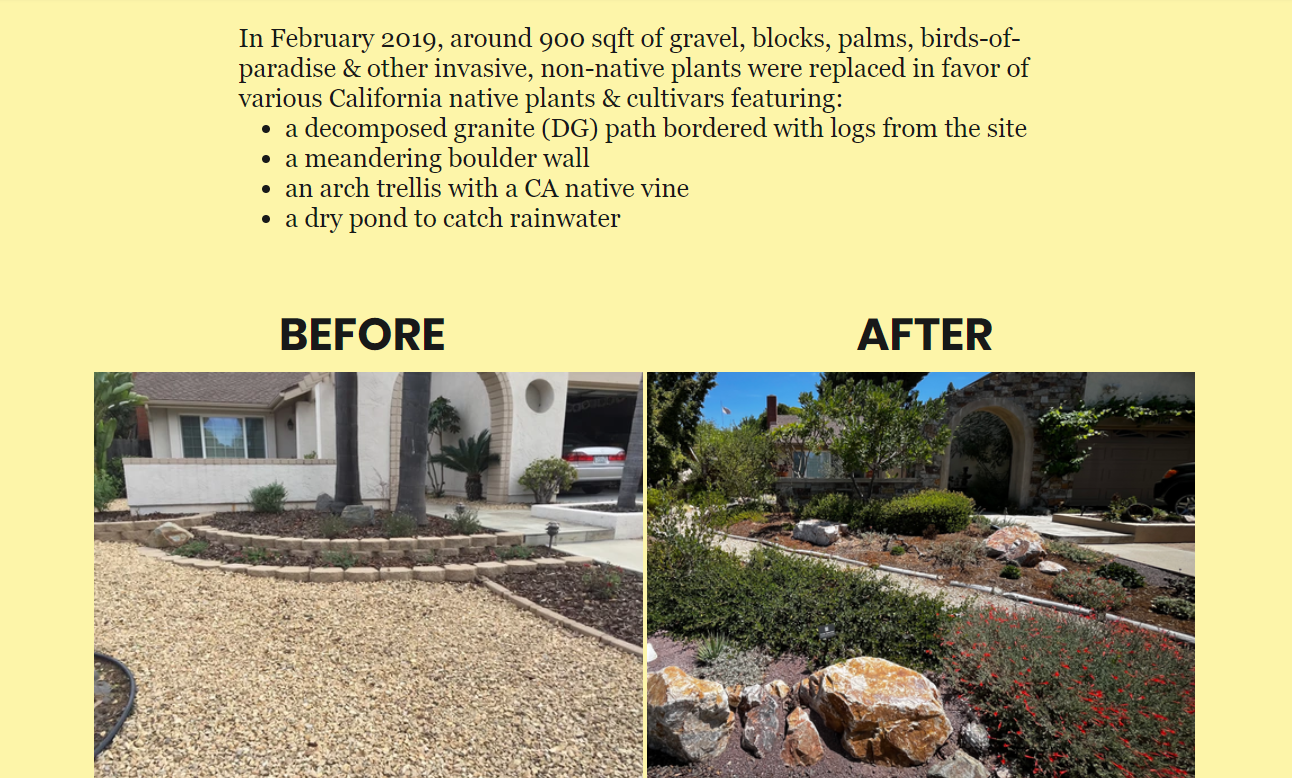
This visual storytelling can be very compelling for potential clients who want to get a better idea of what a full garden transformation means and how long it takes.
Allow your clients to zoom in on your projects
Breathtaking static images can be powerful on their own, but you can impress your potential clients even more by letting them know what those colorful patches actually consist of. One way to do it is by tagging specific plants you’ve used for each project and explaining why they were chosen.
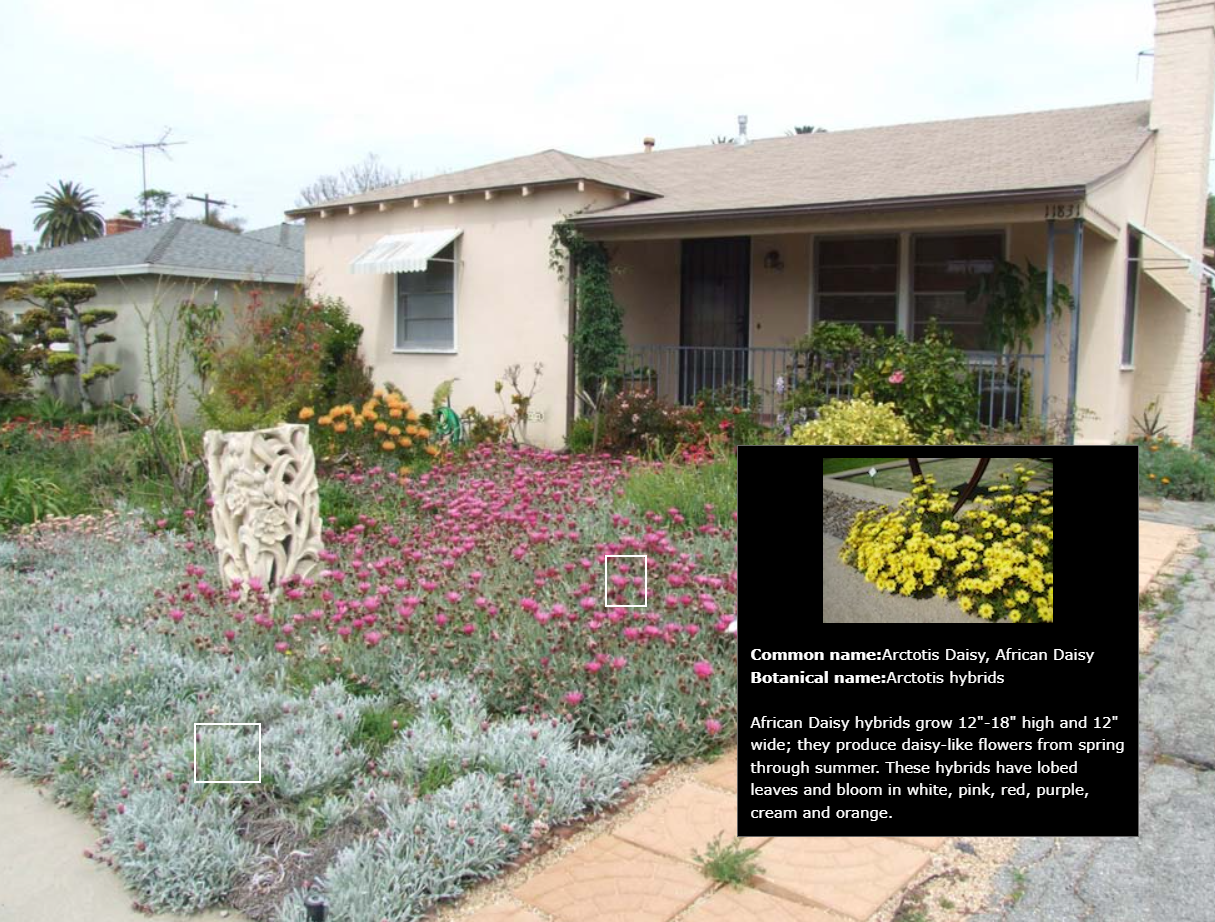
You can top it off with some video content. Consider adding short immersive tours of completed projects or time-lapse videos of the landscaping process. Videos can provide a more detailed view and showcase the quality and scale of your work in action.
Landscaping website copywriting ideas and content marketing tips
The way you describe your company, projects, and services is just as important as the way you visualize them. Here are the main landscaping website copywriting ideas and tips on how to highlight your company’s strong sides and expertise.
Refine your unique selling point
Focus on what potential clients are looking for — beautiful, functional outdoor spaces. Use language that resonates with their desires, such as “transform your yard into a peaceful retreat” or “create a stunning garden that impresses guests.”

Instead of simply listing services, describe how those services meet the clients’ needs and enhance their lifestyle. The goal here is to try and make them visualize that garden of their dreams before they even contact you. Use “you” language to make the copy feel more personal and directed at the reader, making them feel like the center of your service.
Appeal to your customer’s emotions
When describing your approach, be precise and focus on the value you bring to the client’s property. For instance, instead of just offering “landscape design,” describe how your expert designs can “create a cozy outdoor space and fill it with resilient, low-maintenance native plants.”

Although you don’t want to overwhelm your audience with technical details, it is beneficial to mention some techniques, products, and methods you use in order to create a complete professional image.
Make customers resonate with your mission
Don’t forget to share your company’s history, values, and mission in a way that connects with visitors emotionally. Explain why you’re passionate about landscaping and how you do things a bit differently.
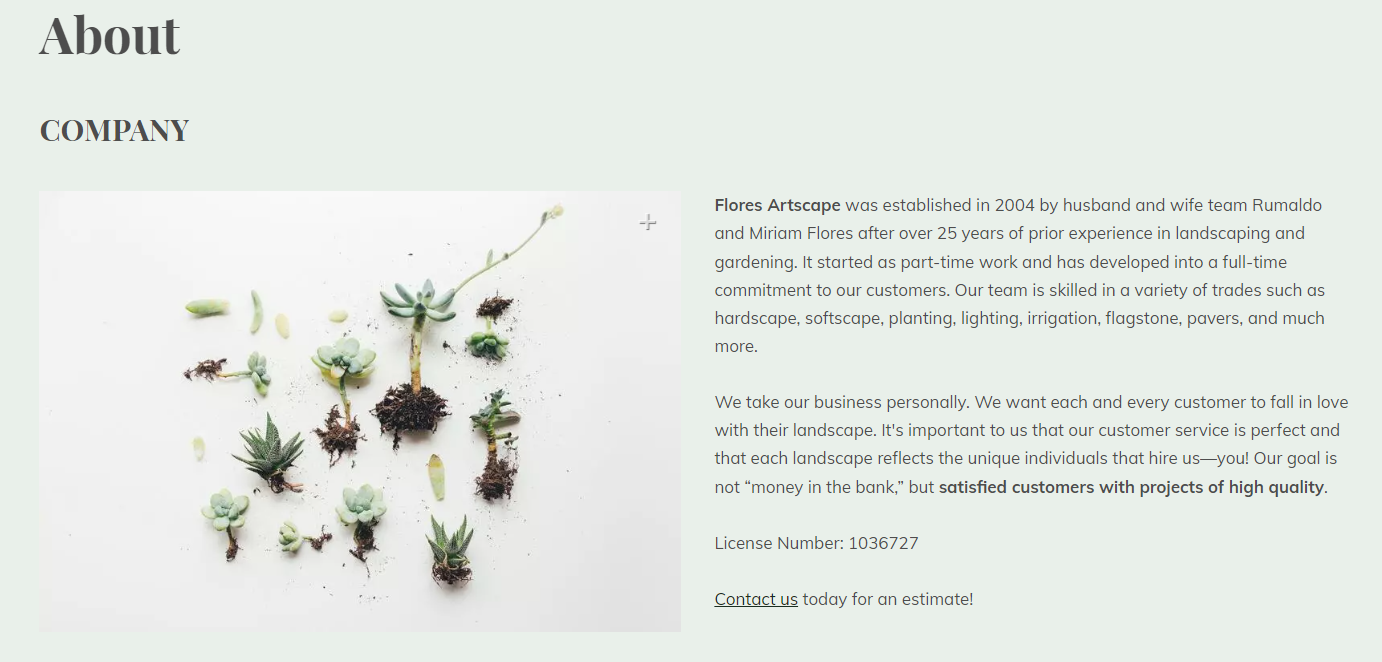
An “About Us” page is a perfect place for telling your story, including any unique traits that set your landscaping business apart. Are you a family-run business? Do you focus on promoting sustainability and permaculture? Make sure to mention that.
Introduce the people behind the brand
To make the customer experience even more personal from the start, introduce your team and list their key competencies as well as their background in gardening and beyond. This will allow even new website visitors to relate to them and develop an initial connection.

Another way to help your soon-to-be clients get to know your team is by scheduling free calls, which are great for addressing customers’ concerns and making them feel heard.
Describe what makes you an expert
To back your claims up, you need to prove that you are an accomplished expert in your field and that you’ve been in this industry for a while. For that, make sure your “About Us” page features your credentials, awards, and community involvement.
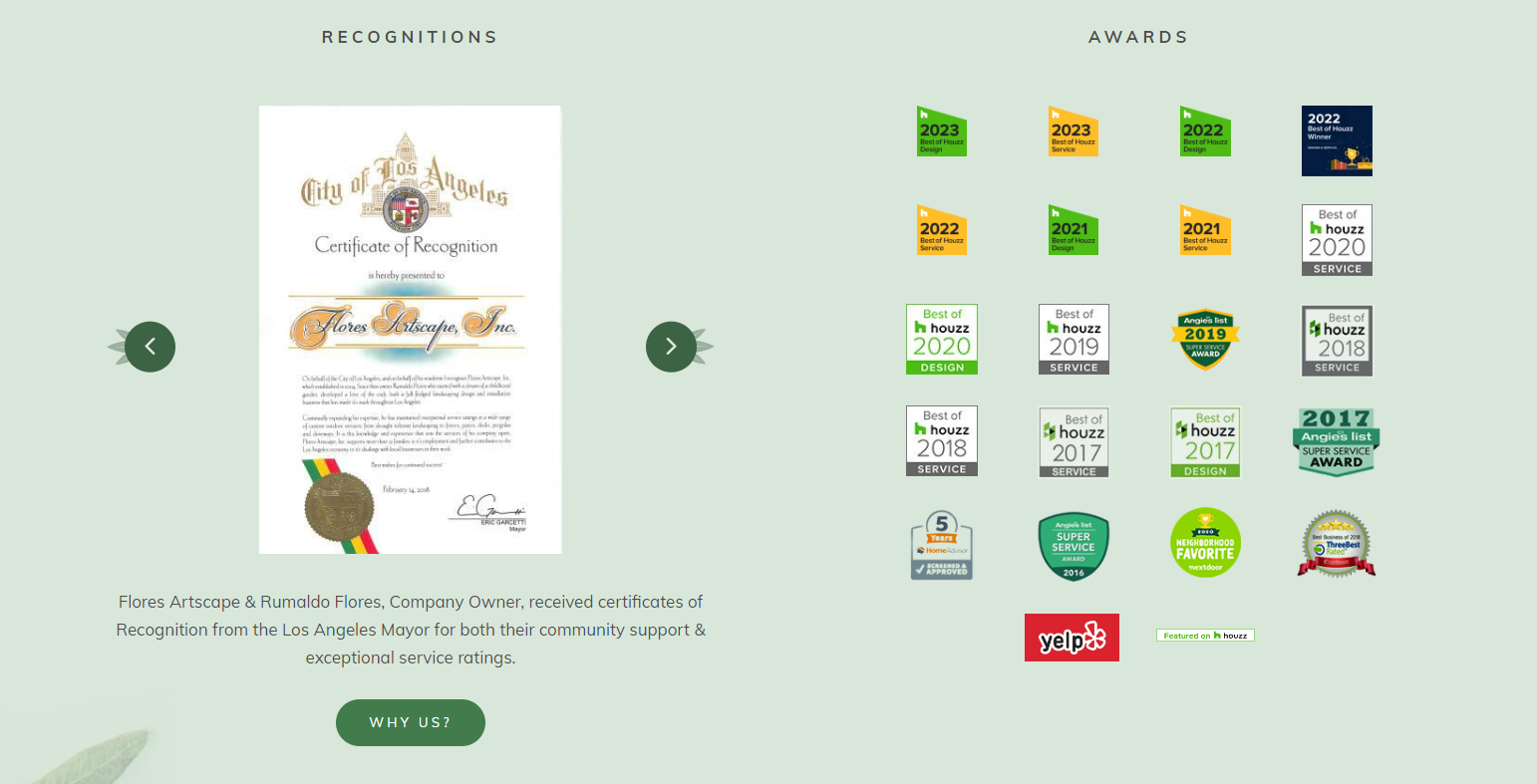
This is a sure way to establish some rapport with the new audience from the get-go and make them trust your expertise without questioning it.
Focus on dominating your local search
Landscaping businesses are inherently local — they often work within a certain region and have a deep understanding of that region’s native plants, weather patterns, water resources, and geological features.
That’s why it’s important to put some effort into your local SEO strategy. Start by using relevant keywords throughout your site, especially in titles, headings, and service descriptions.

Include relevant local keywords throughout your copy, such as the names of the cities or neighborhoods you serve. This helps improve your visibility in local search engine results. Naturally integrate these keywords into your service descriptions, blog posts, and other copy without forcing them, ensuring your content remains readable.
Turn curious visitors into long-time subscribers
Whoever visits your landscaping website for the first time, deserves to be added to your subscriber pool and start benefiting from your in-depth content. To capture their interest, use simple pop-ups that prompt users to share their email addresses in exchange for exclusive outdoor design and gardening tips.
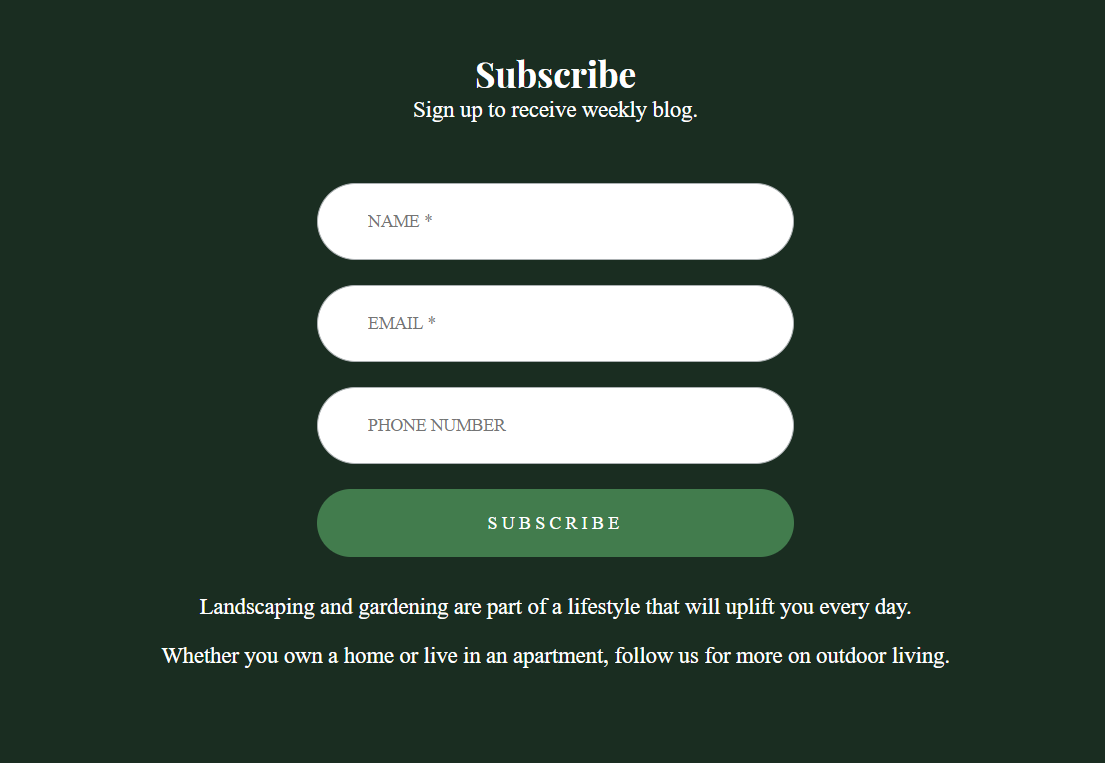
With SendPulse, you can create pop-ups like this one in minutes, using our customizable templates and visual editor. It’s possible to set your pop-up timing in a way that it triggers when your visitor is in discovery mode, open to connect and explore.
Let satisfied clients speak for you
To win over new customers, you need to show them how your existing ones feel about working with you. Include testimonials or case studies that highlight specific successes or transformations you’ve achieved for clients.
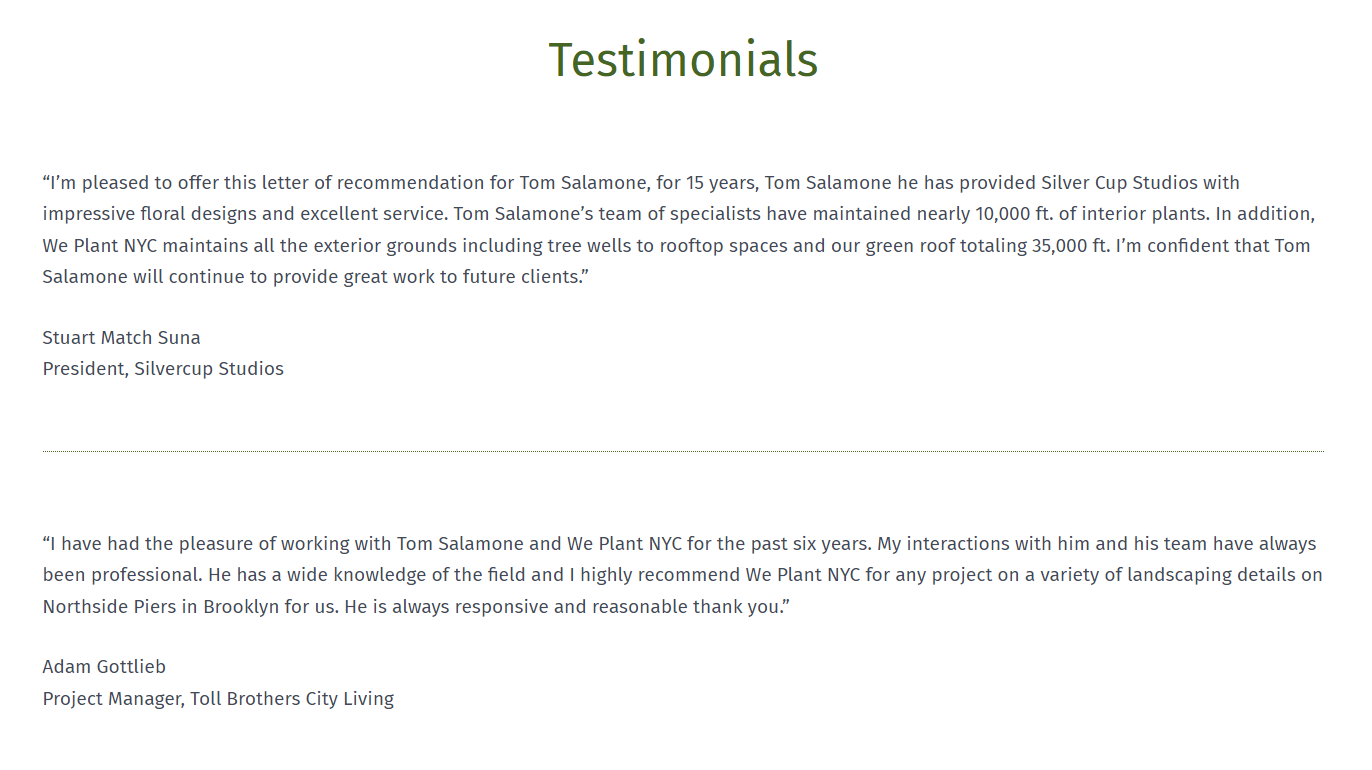
To make them more trustworthy, if possible, mention your customers’ names, job titles, and properties where the work took place.
Share niche content directly related to your services
The best landscaping websites often publish highly specific expert content instead of generic gardening advice because it brings more value to the customers and is more likely to keep them interested.
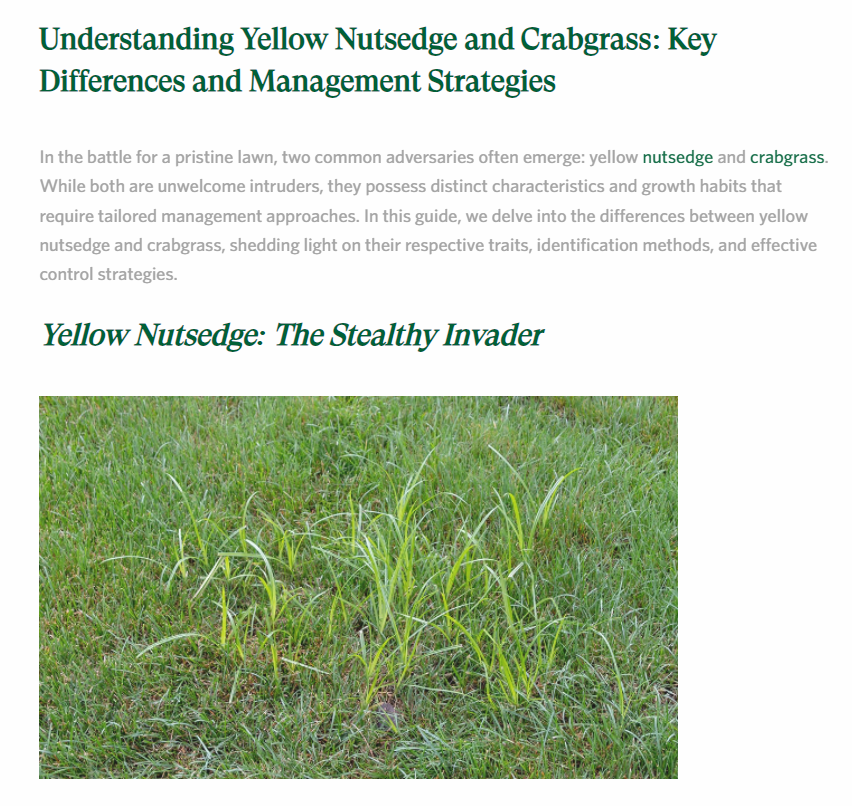
If you already have a blog on your website, make sure to diversify your topics and make them more in-depth — this is a reliable way to demonstrate your knowledge and make people come back to your resource.
Address your users’ objections and concerns
By adding a FAQ section to your website, you can minimize the number of repetitive, surface-level questions your team receives. It’s also useful for dissolving customers’ doubts and helping them understand whether your company is a good fit for them.
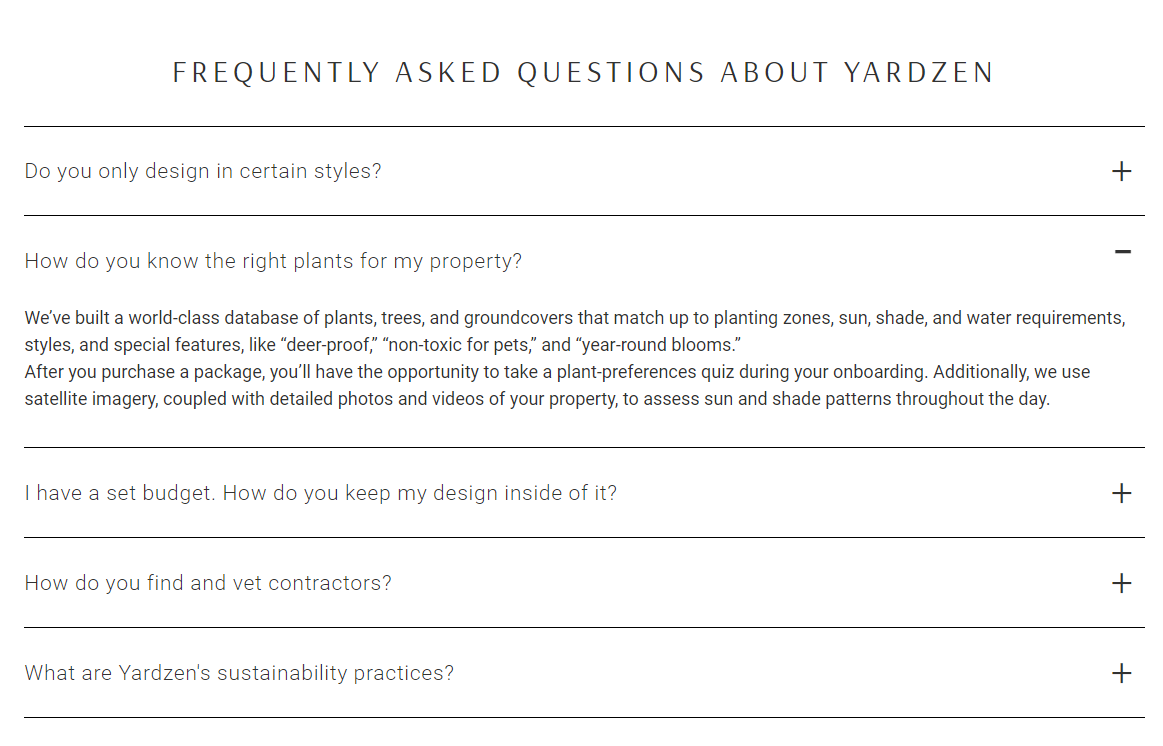
Addressing common questions directly on your site is guaranteed to save you hours of work, but it’s also great for customers, too, as it enables them to form a more detailed request.
How to create websites for landscaping companies with SendPulse
Creating a pixel-perfect landscaping website is easier than you think, at least with our website builder. It is code-free and template-based, but you still get plenty of customization options.
To get started, log in to your existing SendPulse account, or create a new one if you’re not signed up yet. Once inside, navigate to the “Websites” section, where you can create, edit, and manage both single-page landing pages and multi-page websites.
By clicking “Create website,” you will access over 40 fully customizable templates. You can sort these templates by theme and language to find the perfect fit for your landscaping business. To preview any template, simply click on it. Once you’ve found the one that resonates with your brand, click the template’s name to begin editing.
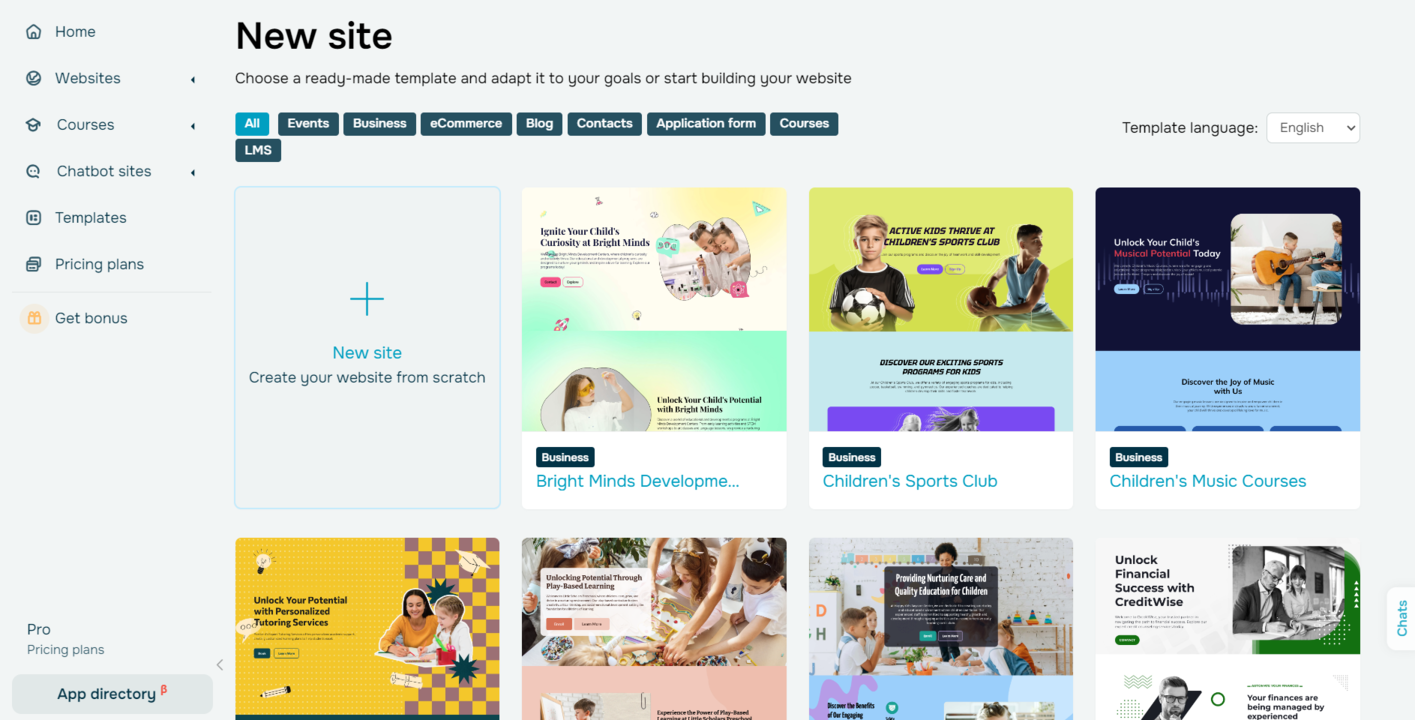
With our visual builder, you can modify the template to align with your brand’s identity. Personalize the structure, text, colors, fonts, and images to reflect your vision. If you want to adjust an element, simply click on it, and an editing panel will appear, allowing you to fine-tune every detail.
Our visually-driven templates are perfect for showcasing aesthetic products or services like landscaping, allowing you to demonstrate your offerings with the help of large galleries, product descriptions, stylized lists, and other website elements. Just click where you want to add them and drag and drop them from the left panel.
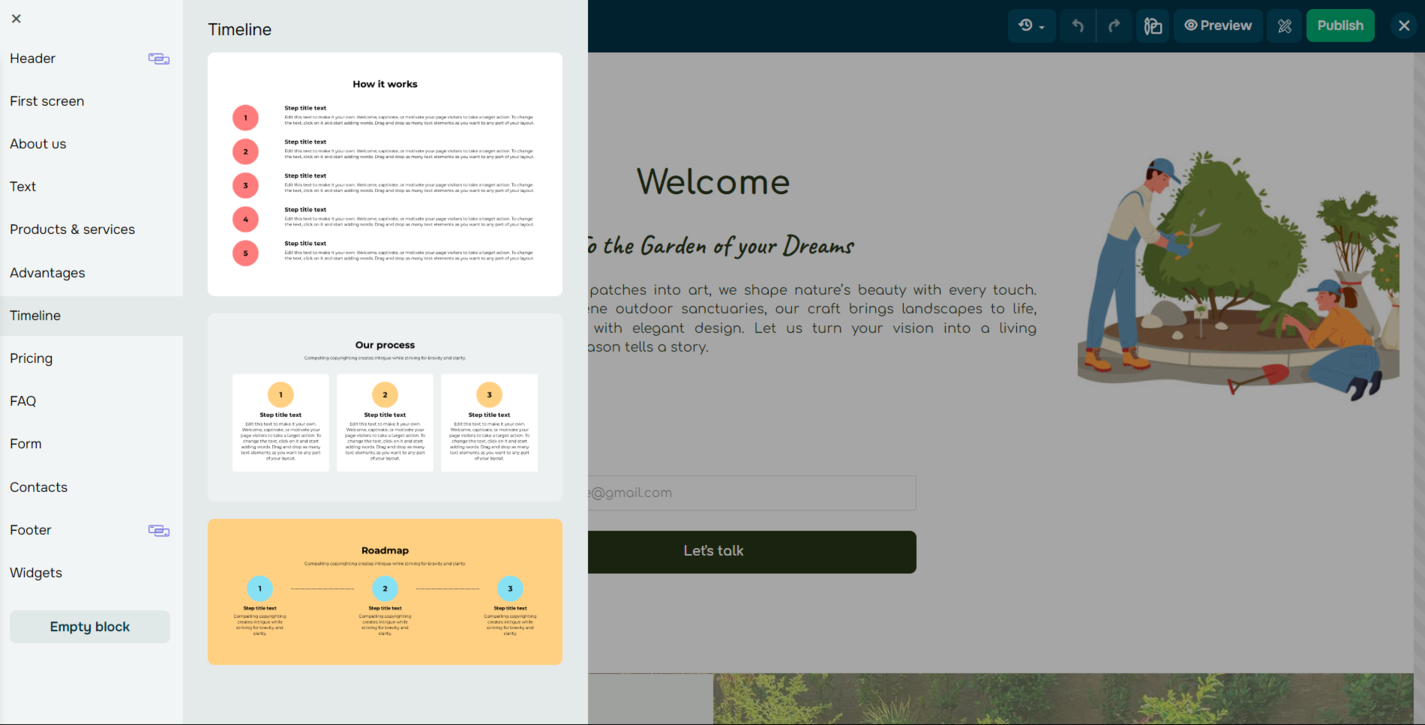
A contact form is essential for small businesses aiming to capture leads. With SendPulse, you can easily integrate a stylish lead form and process customer inquiries through your CRM.
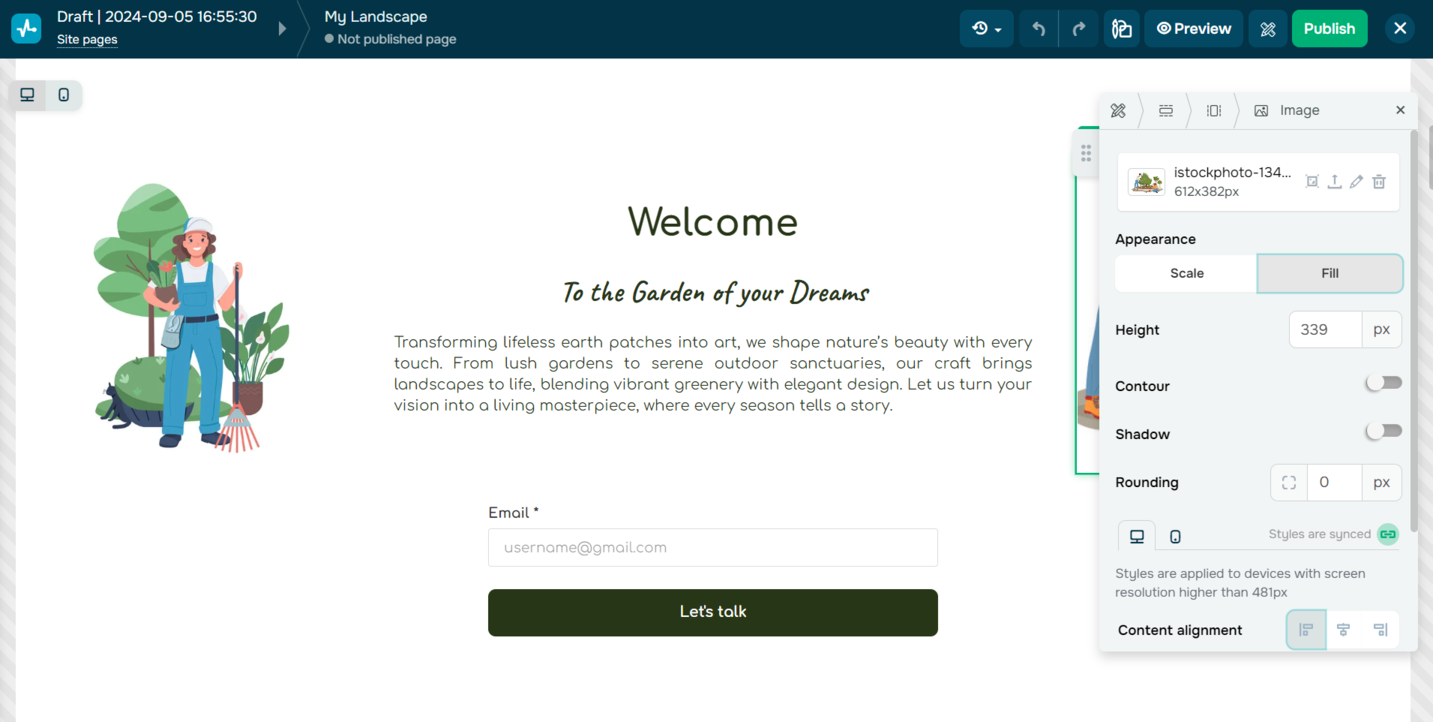
Your changes are saved automatically. You can preview your site at any time by clicking the “Preview” button in the top-right corner to see how it will appear when live. Once satisfied, simply hit “Publish.”
To fine-tune your SEO settings, head back to the “Websites” tab, click the three-dot icon on your website preview, and set your page URL and title — usually, your brand name works well here. Add SEO metadata, target keywords, and a preview image if needed. You can also access these settings directly from the visual builder.
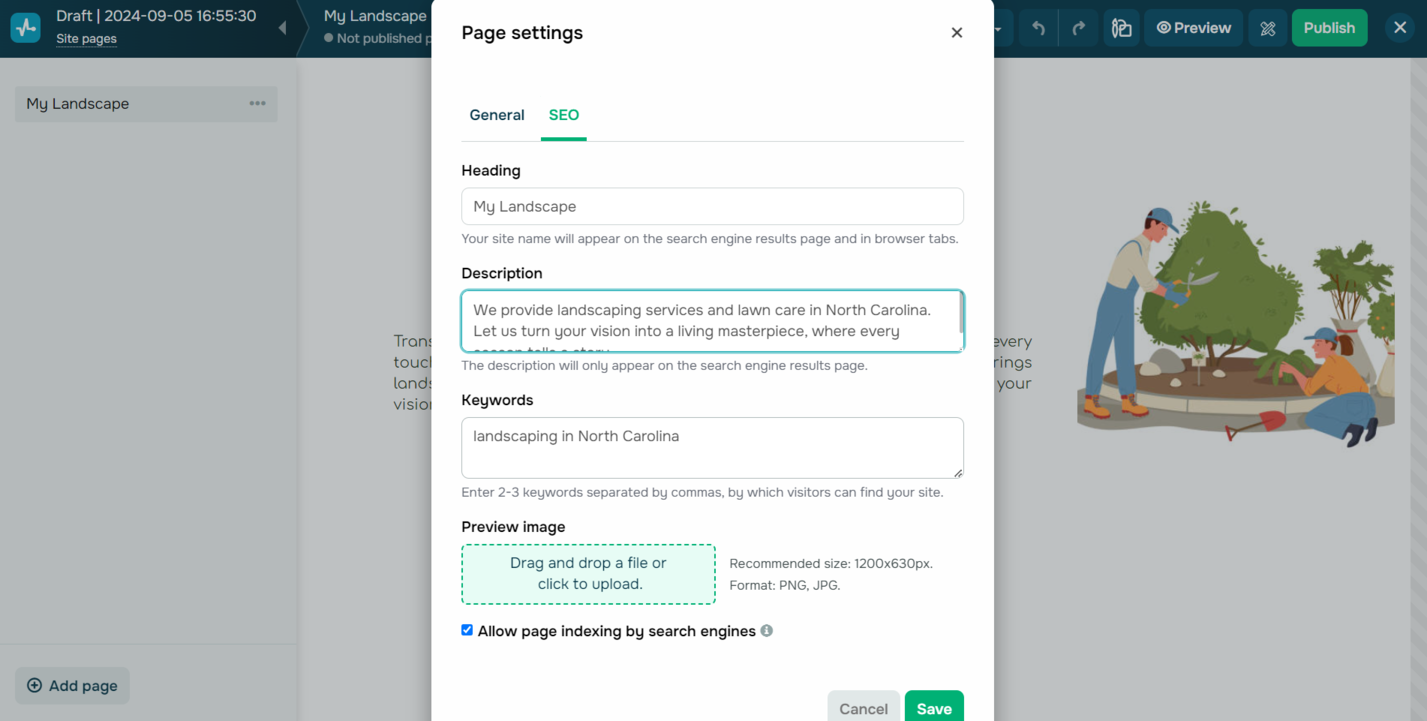
This tab also helps you stay on top of your website’s performance, tracking visits, clicks, subscriptions, and payments. For more detailed analytics, you can integrate Google Analytics and Facebook Pixel — for that, check out our help center.
One more thing
Now that you know what makes the best landscaping websites, it’s time to put that into practice. Explore our all-in-one sales and marketing automation toolkit and start creating highly converting websites, chatbots, newsletters, SMS campaigns, pop-ups, and online courses.
Create your free account to give it a test run!







